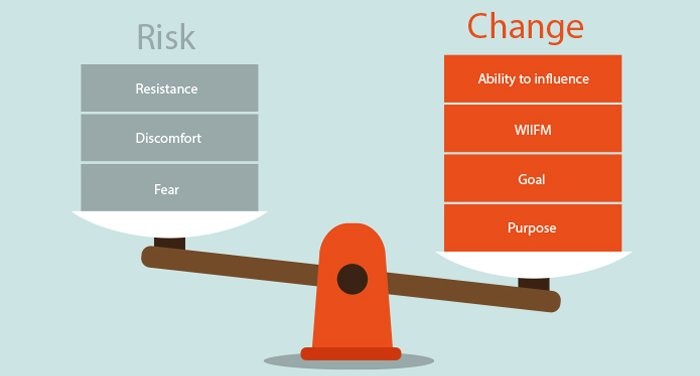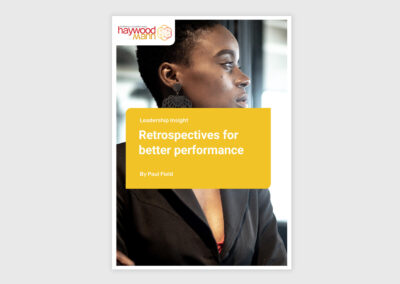Change – a word we hear very often – some would say: ‘too often’… On the other hand, most of us are very aware of the fact that change is an important part of our humanity and growth.
So, what is the difference between changes we like and those we struggle with? – Interesting question.
Let’s compare 2 different situations – both from the world of work – which quite a few of us might have experienced. In both situations, the basis is finding a new member of staff (because the previous person left) and to integrate the new person into the team.
Situation One:
- Robert, the team leader, sits down with HR to discuss the job advert. Together they check the job description and adapt it to the changed requirements of the organisation and the job market.
- HR writes the job advert, pre-screens the candidates and creates a shortlist of the most suitable ones.
- Robert interviews the candidates and hires one of the shortlisted candidates, Karina, who he feels is an excellent match.
- Robert arranges a weekly Jour Fixe with Karina fort the first 3 months, and asks her to get to know and review the processes within the department, feedback her thoughts to him and come up with any ideas for improvements or changes.
- On her first day of work, Robert introduces Karina and tells the team to support her and pro-actively assist in her integration into the team. In parallel, Karina runs through the usual induction programme and begins her work.
- Karina is very engaged, continually seeks clarification about background and structures and asks lots of questions to her colleagues and Robert, also around processes and work flow. She takes notes, works up a few proposals for improvement, and presents those to Robert in their Jour Fixe.
- Robert evaluates their feasibility and gives Karina the authorisation to present her proposals to the team and start their implementation as project leader.
- Robert is present at the presentation, praises Karina for her engagement and declares his support for her proposals.
- The presentation runs smoothly, the team listens and asks few questions.
- Robert praises Karina again at the end and asks the team whether they agree with the implementation.
- Some of the team members nod, some agree verbally, some say nothing.
- Karina starts the implementation; her colleagues are slow in supporting her.
- Some ask her lots of questions and challenge her to justify the changes.
- Some withdraw and create cells of resistance to stop the project.
- Some stop communicating with Karina and refuse to give her information.
- The project slows and does not achieve the first mile stone.
- Robert holds Karina accountable and tells her he expects her to bring the project back onto its time line.
- Karina works even harder to progress the project, working overtime to compensate the lacking co-operation from her colleagues and approaches them even more pro-actively to motivate them to engage with the project.
- 2 colleagues complain about Karina’s aggressive behaviour to Robert and question the purpose of the project.
- Robert listens to the opinions of the 2 team members and promises them to deal with the issue.
- Robert invites Karina to a meeting, where he advises her to engage her colleagues more and chose her behaviour more carefully, so as not to hurt her colleagues’ feelings.
- Karina complains to Robert about the slow speed of collaboration and questions their attitude towards the implementation of the projects.
- Robert assures Karina that he has been leading this team for 5 years and has always experienced the team members as engaged and motivated. Furthermore, everyone had agreed with the project at the presentation.
- Karina continues to work on the project and makes an effort to approach her colleagues in a gentler fashion, the atmosphere in the team relaxes a bit – however the project continues to remain stuck.
- Karina works even longer hours to push the implementation forward. The second mile stone is not achieved either.
- A conversation between Karina and one of her colleagues, Max, escalates into a verbal fight in front of the team.
- Max escalates the situation to Robert.
Can you imagine what happens next?
Situation Two:
- Jeremy, the team leader, invites his team to a discussion about filling the vacancy. He asks everyone to prepare for the conversation around the following topics:
- Think through the processes in the department, regarding potential for improvements
- Critically review the organisation of the department, with regards to achieving the department and business goals for the next 2 years
- Come up with ideas how the role should be changed to optimise the achievement of the goals and support the team optimally
- The team members arrive at the discussion with Jeremy prepared and 2 people bring ideas of how the role could be changed
- Jeremy facilitates the debate of the proposals and contributes his own ideas at the end.
- The team decides to go for a combination of one of Jeremy’s ideas and one of the team member proposals.
- Jeremy volunteers to create the job description with HR, which he will run past the team again, briefly, in a follow-on meeting.
- In the follow-on meeting the team quickly agrees the job descriptions with a couple of small changes in the personality profile for the role.
- HR screens the candidates and creates a shortlist of the most suitable ones.
- Jeremy interviews the candidates and invites Susan and Charles, who are the closest fits for the role description and personality profiles, separately to a ‘getting to know the team’ ½ day session. He advises both that the final decision on who to hire for the role will be taken jointly in the team.
- At the start of the ½ days Jeremy facilitates a 2-hour meeting between the team and Susan/Charles around the departmental and organisational goals for the next couple of years and the purpose of the new role in optimising the achievement of these.
- The team actively engages in the discussion and collaborates with Susan/Charles regarding what s/he sees her/his contribution to be, how s/he sees the role, which structures and processes are needed to successfully fill the role and what the team expects of her/him concerning effective collaboration and communication.
- After the meeting, Jeremy withdraws for 90 minutes and invites the team to – together with Susan/Charles – come up with a priorities plan for the first 90 days in role.
- In the final 30 minutes of the ½ day, everyone gets together again for a brief discussion of the plan, plus an exchange of feedback between the team and Susan/Charles about their time together.
- The following morning Jeremy and the team meet and discuss the previous day and the team’s impressions of Susan/Charles and which of the two looks to be the closer match for the role and the team.
- Both candidates are viewed by the team as good fits, with the technical and behavioural competences for the role.
- At the end of the discussion, the team takes an open vote – without Jeremy. He is given the casting vote in case the team’s decision is inconclusive.
- The team decides for Susan, with clear majority.
- Jeremy invites all team members to explain their vote. At the end of that discussion, Jeremy invites those team members who voted for Charles to voice any concerns they might have about Susan. Those are being discussed and during the discussion they are cleared up.
- At the end of the meeting all team members are happy to carry the decision.
- Jeremy gives Charles the feedback from the team and offers Susan the role, who accepts it with pleasure.
- On the morning of Susan’s first day, the whole team gets together to discuss, refine and re-check the priorities of the ‘first 90 days’ Plan they worked out together. Furthermore, the team presents their collaboration rules and communication processes to Susan and asks for her feedback on them. Susan declares herself happy with all of them and proposes a weekly Jour Fixe with the team for the first 90 days: on the one hand, to assure her progress according to plan and, on the other hand, to allow her to give the team well-founded feedback on the existing processes and structures and their effectiveness to achieve the goals.
- The team agrees to extend the existing weekly update by 15 minutes, with the provision to call a separate meeting if deemed necessary.
- In parallel Susan runs through the usual induction programme and starts work.
- She engages pro-actively, continually seeks clarification about background and structures and asks lots of questions to her colleagues and Jeremy, also around processes and work flow. She takes notes, works up a few proposals for improvement, and presents those to the team in their weekly team updates.
- The proposals are being discussed in a lively and open debate, one is accepted for implementation and 2 team members step forward to co-drive them with Susan. The team agrees mile stones, and regular updates with the whole team are diarised.
- The first mile stone is achieved, the second missed due to circumstances outside the project team’s control. The project team informs the whole team (in one of the updates) in advance and presents a couple of proposals, how to get the project back on track.
- The proposals are discussed and accepted.
- The project team continues their work on the project.
Can you imagine what happens next?
What are the differences between Situation 1 and 2 regarding:
- Robert’s and Jeremy’s behaviour?
- The environment that either of them creates through their behaviour?
- The reaction of their respective teams because of that environment?
- The situation Karina/Susan find themselves in because of that environment?
- The integration of Karina/Susan in Robert’s/Jeremy’s team?
A few thoughts on change, which might assist with answering the above questions – and the understanding of the two described situations:
- Change creates uncertainty (something changes, so the result is uncertain)
- Certainty is a need of most people – at varying levels
- As the result of change – per definition – is unsure/cannot be guaranteed, change creates a certain amount of risk
- Risk creates discomfort or even fear in a great number of people
- People who are afraid tend to resist, rather than positively engage
- This resistance can take various forms – for instance: attack, withdrawal, ‘playing dead’, ignoring, undermining, building cells of resistance, passive resistance, etc.
- Discomfort and fear are feelings, which are hard to resolve through rational debate, as they are happening on a different level
- People who are afraid and take steps of resistance often struggle with recognising or resolving the emotions behind their actions
What do people need to feel safer during a period of change to accept – or engage with – the change?
- Understanding of the PURPOSE of the change – Why does it makes sense to change? – begets comprehensibility
- Understanding of the AIM/GOAL of the change – What do we want to achieve with this change? – begets clarity about the direction of the change and with that a view to future certainty
- Understanding the PERSONAL GAIN the change could bring them – What’s in it for me? How do I benefit from this change? – begets relevance and motivation to engage
- Opportunity to INFLUENCE the change – What is my contribution to the change and how can I influence the way we change? – begets a feeling of control (and with that a form of certainty) and engagement


